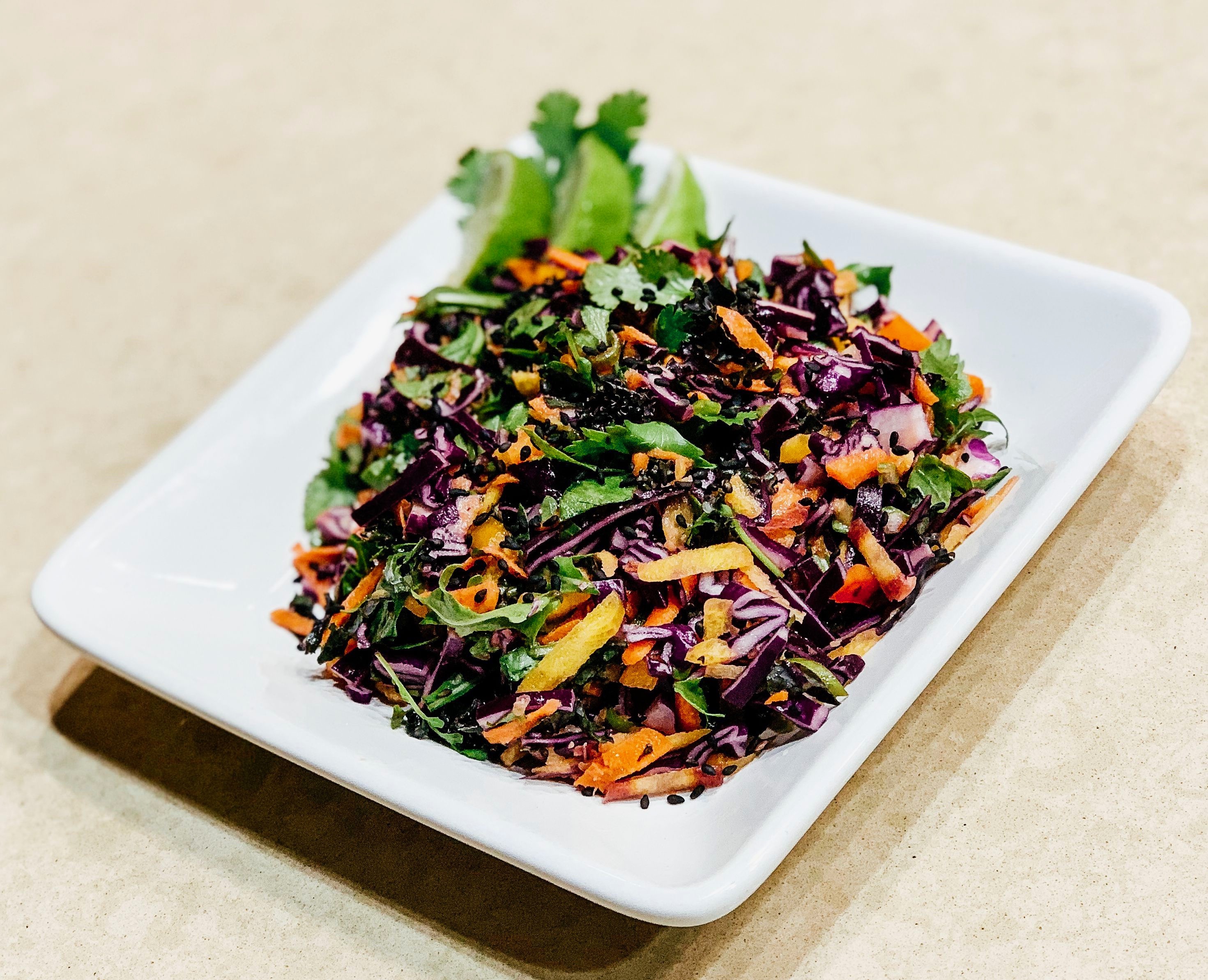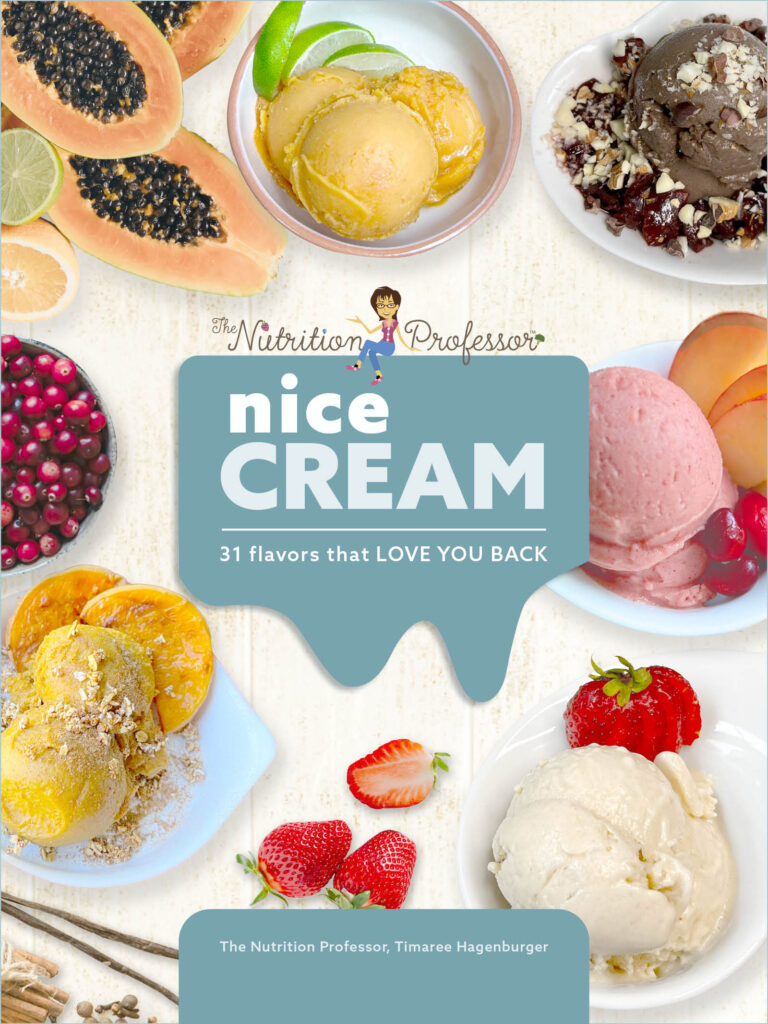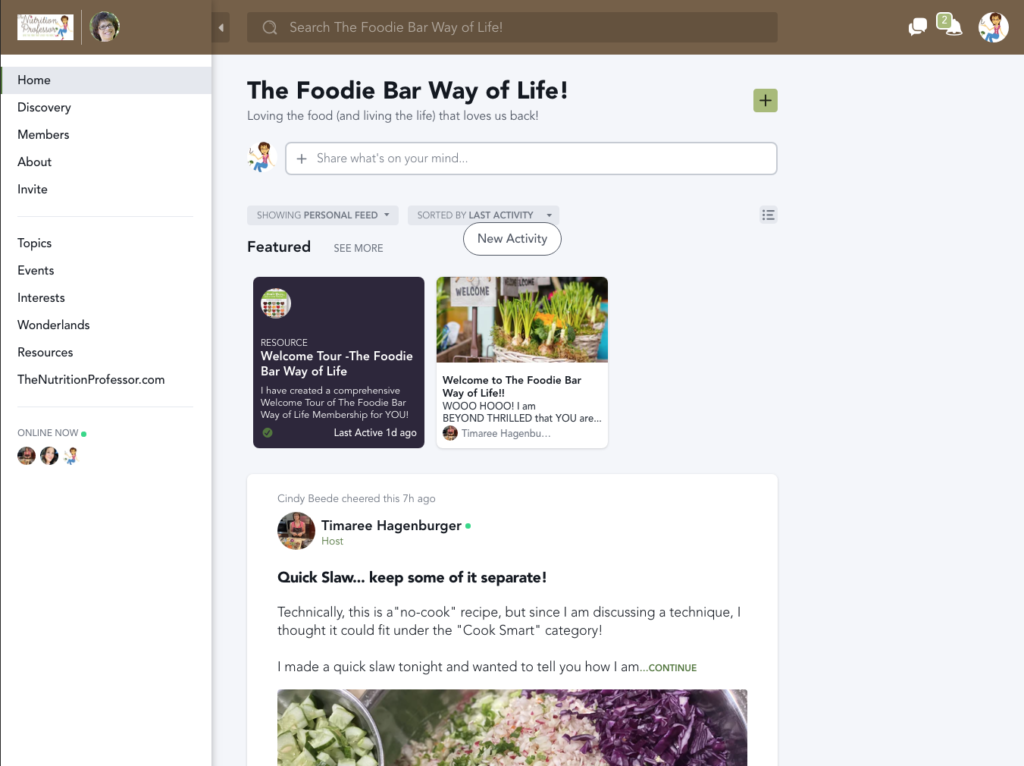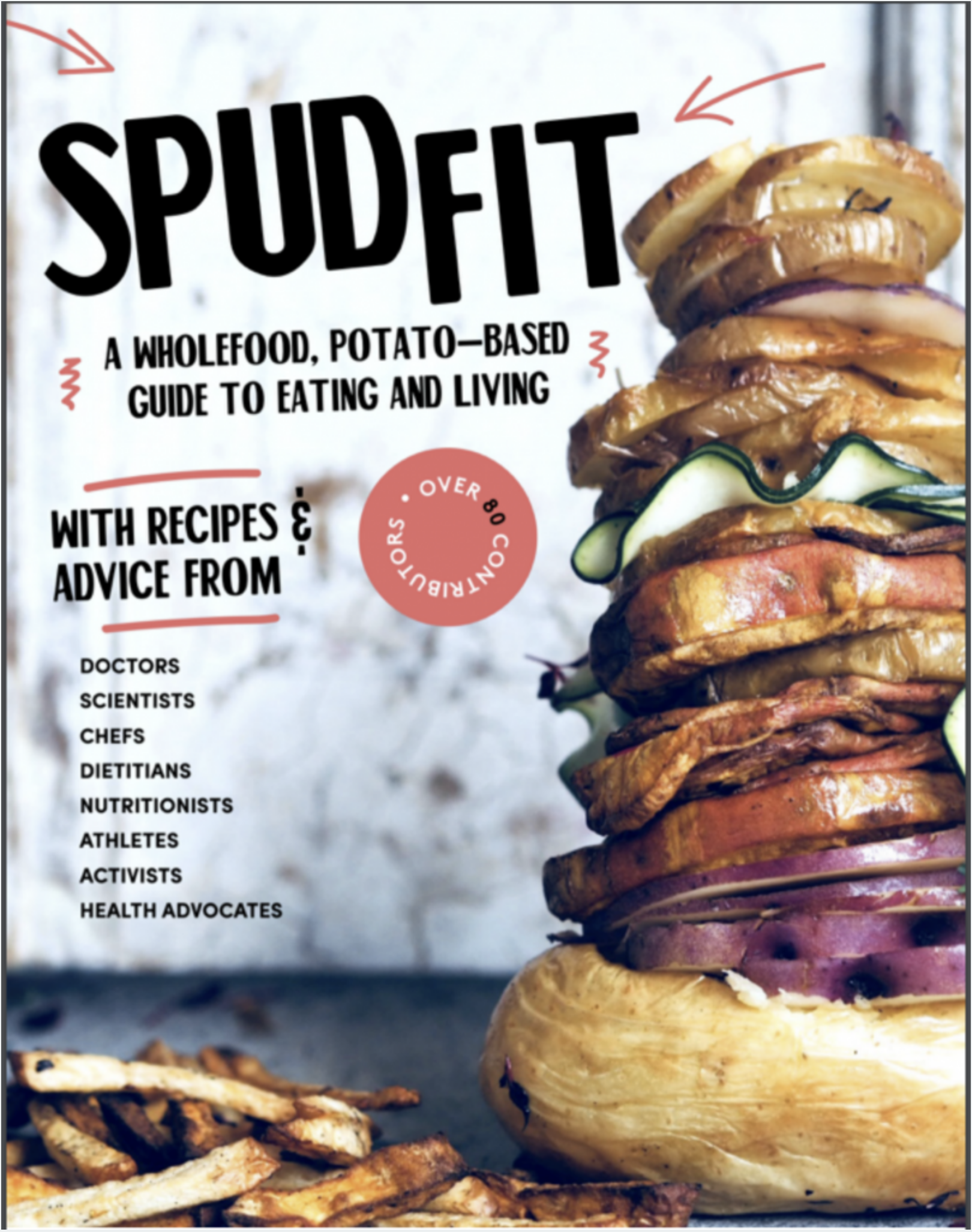Happy National Nutrition Month!!! Perfect timing for the third article in my series about getting out the the “Try Trap”… If you have ever said “I try to eat enough vegetables,” you may have realized that it can be pretty easy to get stuck in the awkward space between learning something new and implementing it. No worries, though! I have some practical strategies and a tasty recipe to celebrate Spring and the amazing vegetables just waiting to tickle your tastebuds and support the healthiest version of you!
While some of my students grew up in families who ate a variety of veggies, many have a relatively narrow “comfort zone” when it comes to vegetables they incorporate on a regular basis. While peas and carrots are great, they don’t provide enough of a variety of phytonutrients to enable our bodies to thrive. When I think about vegetables, I get excited!!! SOOOOO many possibilities, textures, colors, nutrients and more! However, when some of my students hear me say the word “vegetables” they don’t always have such a positive reaction. They may conjure up images of pale, wilted, iceberg lettuce and mushy, tasteless tomatoes that they take off their burgers or out of their sandwiches, overcooked or strong-smelling broccoli or cauliflower that they leave on their plates, or canned spinach that hasn’t seen the light of day for who knows how long… No more!!! We can preparing vegetables in ways that entice people to enjoy every bite!
Mindset Switch – If we adopt a mindset marked by experimentation, the pressure is off when we make a new recipe or use a vegetable in a way that is new for us (e.g. substituting fresh spinach leaves on sandwiches instead of lettuce, mashing lightly steamed cauliflower and potatoes together with roasted garlic or using baby bell peppers sliced in half from stem to tip as a dipper for hummus instead of crackers).
Taste and Tweak – When you think of your kitchen as a culinary laboratory, you can follow a recipe (the first time), sample along the way and have fun tweaking the ingredients to move from “tastes pretty good” to “tastes great” to “tastes super!” The principles you want to keep in mind include color, texture and flavor.
Color – We begin the eating experience with our eyes, so your plate should represent as many colors of the rainbow as possible. Not only will the retinal cells in your eyes be stimulated, which will communicate with your digestive organs, but the naturally occurring plant pigments ARE the health-promoting phytonutrients that protect your cells! Are your meals in need of a colorful upgrade?! There are so many options! You can enjoy lots of deep greens (leafy greens, broccoli, asparagus), reds/purples (tomatoes, beets, purple carrots/potatoes/cabbage, eggplant), orange (carrots, squash, sweet potatoes, bell peppers) and more!
Texture – in many dishes, a mixture of textures is very desirable… so when you serve a hearty chili, topping it with some crunchy pepitas, thinly shredded red cabbage and finely sliced red onion will not only up the nutrient density, but can take the eating experience to a whole new level! Some individuals have told me that they don’t “like” the texture of beans. My next question is usually, “Do you like edamame?” If they have tried them, then they typically respond positively, as edamame seem to be somewhere between a bean and a nut when it comes to texture and they are a great place to start! They can be enjoyed as a snack, in a brown rice or noodle based dish, or even in minestrone soup! Let your creativity flow when it comes to legumes! I always recommend trying all different types with an open mind, as you might be surprised how much you would enjoy garbanzo beans in a salad (or made into hummus), red lentils cooked into a pasta sauce or black beans in tacos, burritos or enchiladas! To add crunch, consider shredded cabbage, and/or carrots, celery, baby bell peppers, jicama or water chestnuts, all diced small. Texture can also be added with sprinkle of chopped walnuts, sesame seeds, hemp seeds, ground flax seeds, and/or a salt-free, multi-herb/spice seasoning blend.
Flavor – Since each of us have different flavor preferences and taste is learned, it is great to be able to modify the spicy, sweet and sour qualities of a dish. If you like your food spicy, play around with incorporating arugula, watercress, mustard greens, radicchio and different types of radishes (they will be “hotter” when grown in warm weather and left in the ground for a few extra weeks to develop more cancer-fighting isothiocyanates). While fruit is the natural “go-to” when it comes to adding sweetness to a recipe, caramelizing onions (recipe here and in my fun and very helpful cookbook) and roasting carrots, sweet potatoes and butternut squash can all produce palate-pleasing results! Drizzling your dish with a bit of your favorite vinegar or a squeeze of fresh citrus juice can provide just the right amount of sour to balance the overall flavor profile. A splash of hot sauce or spoon of your favorite salsa can also be a great addition to many dishes.
Be flexible – embrace The Foodie Bar™ Way approach and consider a variety of mix-and-match options… If you don’t enjoy cilantro, use parsley instead. If you don’t have black beans on hand, use kidney beans. If you don’t have vinegar, experiment with fresh lime, lemon or even grapefruit juice (or a combination of them). The bottom line is to get busy in the kitchen!!! As I have said before, it is virtually impossible to steer a parked car, so get rolling by experimenting in the kitchen! You can quickly develop culinary wisdom by using different techniques and ingredients and paying attention to how each impact the results! Better yet, invite a friend over and have a “Cook2gether,” so that you can talk, laugh and cook simultaneously, and then split up the food you make to enjoy throughout the week.
Ridiculously Delicious Purple Cabbage Salad with “Li-Miso” Dressing
I love the balance of textures and flavors in this colorful and extremely delicious dish! Find more ideas for additions in the “Tips” section below the recipe.
Ingredients
½ medium purple* cabbage, sliced thin (2-3 cups)
3-4 small red, orange and yellow sweet bell peppers, diced
½ cup cilantro*, roughly chopped
2-3 cups roughly chopped “power greens” (your favorite mix of fresh greens: baby kale, collards, arugula, bok choy, etc.)
2 carrots, as colorful* as possible, diced or grated
2 scallions, chopped small (green and white parts) – reserve some for topping
½ avocado, diced (add JUST before serving)
1-2 TBSP black sesame seeds
Optional additions* – see “Tips” section below the recipe!
Li-Miso Dressing
Ingredients
1 lime – juice and zest*
1 tsp almond* butter
2 tsp miso* paste
1 Medjool date*, chopped and soaked in 3 TBSP water (you will use the soaking water)
Procedure
Combine all of the dressing ingredients in a mini food processor or blender/bullet (you can easily double the dressing recipe, store what you don’t use in a mason jar in the refrigerator and enjoy it for several days). Assemble the salad by putting all of the ingredients together is a large bowl, mixing well, then tossing with dressing. Add avocado just before serving and sprinkle each serving with black sesame seeds and some extra diced scallions.
The Nutrition Professor’s Shop Smart, Prep Smart, Cook Smart, Eat Smart Tips:
*You can also add in some savoy cabbage, along with the purple cabbage for a slightly different texture.
*If you discover that you enjoy slightly softer cabbage and carrots, steam them gently before assembling the recipe.
*If you are not a fan of cilantro, use a different fresh herb – like parsley!
*I love using purple, yellow, white and orange carrots, available at many grocery stores and local Farmers’ Markets.
*Zest the lime using a Microplane before squeezing it for juice.
*If you would prefer peanut butter, then use it in place of the almond butter, or even substitute walnuts or soaked, raw sunflower seeds (for a nut-free option).
*Miso paste is a flavorful, fermented ingredient that can be found Asian section of supermarket (often in the refrigerated section of the produce area). A little goes a long way in creating the umami (savory) flavor.
*If you don’t have a date, (invite someone over), and use 2-3 tsp of raisins or a soaked dried apricot.
*A few wonderful ingredients to consider adding to this dish include: mango or orange sections (diced very small), kidney beans, edamame, julienned cucumber, radishes and/or water chestnuts. You can even toss in some soba noodles or cooked whole grain (like quinoa, purple rice, barley or farro), as well.
Timaree Hagenburger, a plant-based registered dietitian nutritionist (RDN), certified exercise physiologist with a master’s degree in public health, has over 20 years of experience as a nutrition professor. She is a sought after speaker, media personality and author, who works with private clients, and in corporate wellness, has contributed to several cookbooks and published her own cookbook, The Foodie Bar Way: One Meal, Lots of Options, Everyone’s Happy (www.foodiebars.com)! Timaree is also the founder of an incredible online membership community, The Foodie Bar Way of Life, that makes loving the food (and living a life) that loves us back… simple, satisfying, sustainable AND FUN! You can contact her about working with her through 1:1 dietitian nutrition coaching, for hands-on cooking instruction and to inquire about arranging a speaking engagement.


 Order and learn more at www.FoodieBars.com
Order and learn more at www.FoodieBars.com

 This is a first for me... Some of MY recipes are part of a rock star compilation cookbook put together by Andrew Spud Fit Taylor!! Order it today!
This is a first for me... Some of MY recipes are part of a rock star compilation cookbook put together by Andrew Spud Fit Taylor!! Order it today!